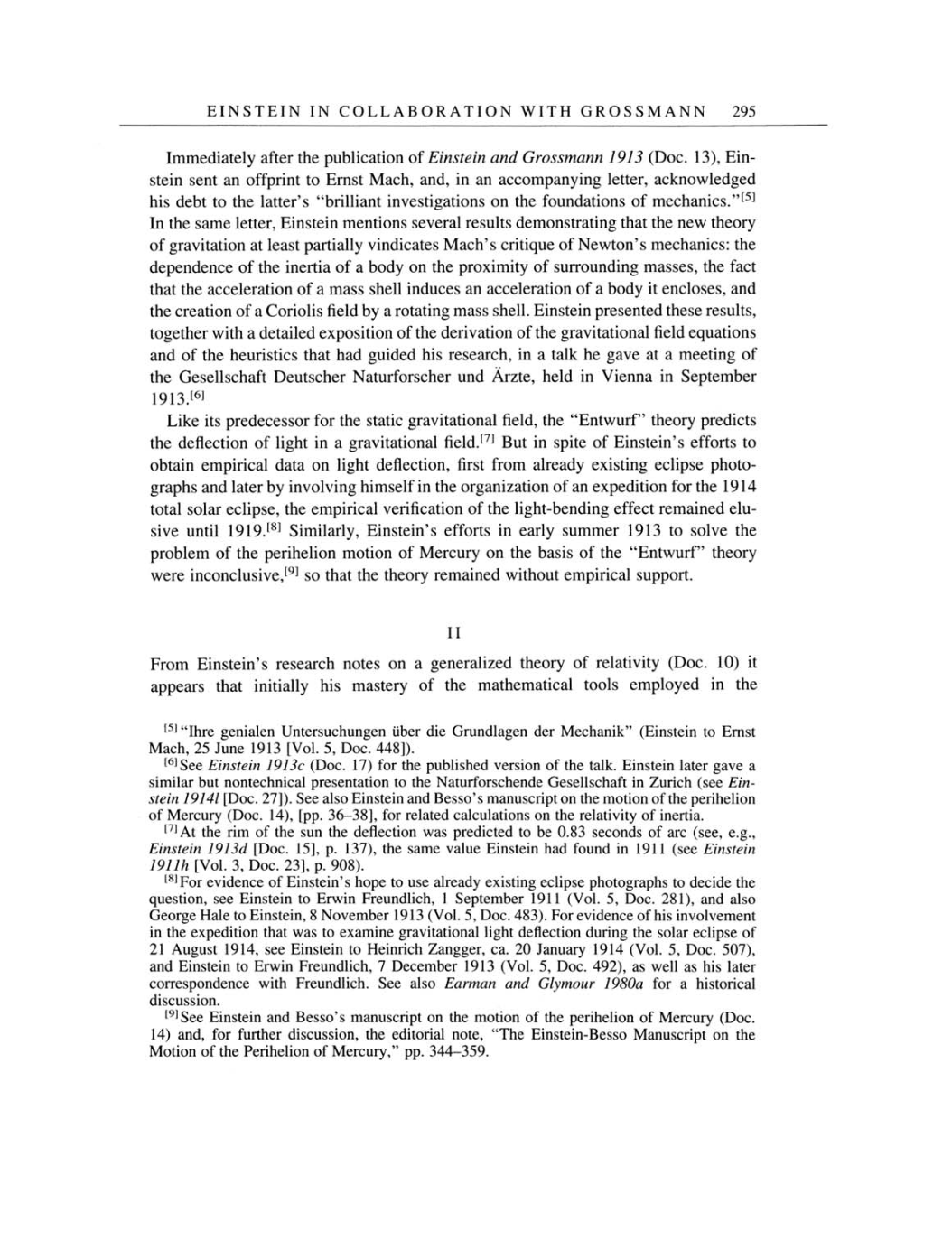EINSTEIN IN
COLLABORATION
WITH
GROSSMANN
295
Immediately
after
the
publication
of Einstein and Grossmann
1913
(Doc. 13),
Ein-
stein sent
an offprint
to
Ernst
Mach,
and,
in
an
accompanying letter, acknowledged
his
debt
to
the
latter's "brilliant
investigations
on
the
foundations of
mechanics."[5]
In the
same
letter,
Einstein
mentions several results
demonstrating
that
the
new
theory
of
gravitation
at
least
partially
vindicates Mach's
critique
of Newton's mechanics:
the
dependence
of
the
inertia of
a
body
on
the
proximity
of
surrounding masses,
the
fact
that
the
acceleration of
a mass
shell
induces
an
acceleration of
a
body
it encloses, and
the
creation of
a
Coriolis
field
by a
rotating
mass
shell.
Einstein
presented
these results,
together
with
a
detailed
exposition
of
the
derivation of
the
gravitational
field
equations
and
of
the
heuristics that had
guided
his research, in
a
talk
he
gave
at
a
meeting
of
the
Gesellschaft Deutscher Naturforscher und
Arzte,
held
in
Vienna
in
September
1913.[6]
Like
its
predecessor
for
the static
gravitational field,
the
"Entwurf"
theory predicts
the
deflection
of
light
in
a gravitational
field.[7]
But
in
spite
of Einstein's efforts
to
obtain
empirical
data
on
light
deflection, first
from
already existing eclipse photo-
graphs
and
later
by
involving
himself
in the
organization
of
an
expedition
for
the 1914
total
solar
eclipse,
the
empirical
verification of the
light-bending
effect remained
elu-
sive
until
1919.[8] Similarly,
Einstein's efforts
in
early
summer
1913 to solve the
problem
of
the
perihelion
motion of
Mercury
on
the
basis of
the
"Entwurf"
theory
were
inconclusive,[9]
so
that
the
theory
remained without
empirical
support.
II
From Einstein's research
notes
on
a generalized
theory
of
relativity (Doc.
10)
it
appears
that
initially
his
mastery
of the
mathematical tools
employed
in the
[5]"Ihre
genialen Untersuchungen
über
die
Grundlagen
der Mechanik"
(Einstein to
Ernst
Mach, 25
June
1913
[Vol.
5,
Doc.
448]).
[6]See
Einstein
1913c
(Doc. 17)
for
the
published
version of
the talk.
Einstein later
gave a
similar
but
nontechnical
presentation to
the
Naturforschende Gesellschaft
in
Zurich
(see
Ein-
stein 1914l
[Doc. 27]).
See
also Einstein
and
Besso's
manuscript
on
the
motion of
the
perihelion
of
Mercury
(Doc. 14), [pp.
36-38],
for related calculations
on
the
relativity
of
inertia.
[7]At
the
rim of
the
sun
the
deflection
was
predicted
to be 0.83
seconds of
arc (see,
e.g.,
Einstein 1913d
[Doc. 15],
p.
137),
the
same
value Einstein
had
found
in 1911
(see
Einstein
1911h
[Vol.
3,
Doc.
23],
p.
908).
[8]For
evidence of Einstein's
hope
to
use
already
existing eclipse photographs
to
decide
the
question,
see
Einstein
to
Erwin
Freundlich,
1
September
1911
(Vol.
5,
Doc.
281),
and also
George
Hale
to
Einstein,
8
November
1913
(Vol. 5,
Doc.
483).
For evidence of
his
involvement
in the
expedition
that
was
to
examine
gravitational light
deflection
during
the
solar
eclipse
of
21 August 1914, see
Einstein
to
Heinrich
Zangger,
ca.
20
January
1914
(Vol.
5,
Doc.
507),
and
Einstein
to
Erwin
Freundlich,
7
December
1913
(Vol. 5,
Doc.
492),
as
well
as
his
later
correspondence
with
Freundlich.
See
also Earman and
Glymour
1980a for
a
historical
discussion.
[9]See Einstein
and
Besso's
manuscript
on
the
motion of
the
perihelion
of
Mercury (Doc.
14) and,
for further
discussion, the
editorial
note,
"The Einstein-Besso
Manuscript
on
the
Motion of
the
Perihelion of
Mercury,"
pp.
344-359.
